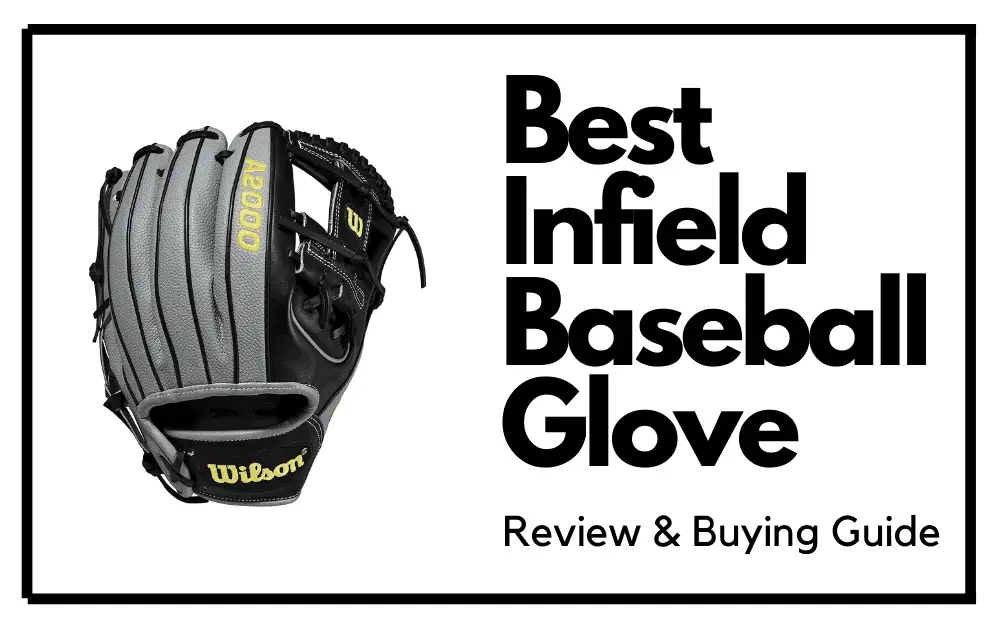

Table of Content
When you’re an infielder, you’re always in the thick of things. In a real game, it’s not about the big home runs. Instead, it’s one base at a time. So, if you – the infielder – keep making mistakes and letting the runner steal a base, you’ll face a lot of heat in the locker room.
I remember one time when one of my trainees used an 11-inch glove in the infield. Now, the glove is an awful fit for him. I didn’t realize something was wrong until he missed two catches and ten groundballs. I was furious. And as expected – we lost. But my entire team learned a very important lesson that day.
A TRASH GLOVE CAN (AND MOST CERTAINLY WILL) COST YOU THE GAME!
So, you should always go into the diamond with the best infield gloves. Trust me – the performance you’ll get will be game-defining. Not all infield gloves are of the same caliber. And some gloves are age-specific. You have to be careful during the selection/screening process.
That’s why I’m going to help you navigate through the different gloves and show you what exactly you can get for the moolah you spend. Let’s dive in.
6 Best Infield Gloves
So, you’re on the lookout for some top-shelf infield mitts. Well, I’ve been where you are, tested a lot of different things, and came out with a ton of surprising insights. And I’m going to share the fruits of my labor with you.
1. Rawlings PRO Preferred Baseball Glove (Best Premium Infield Glove)
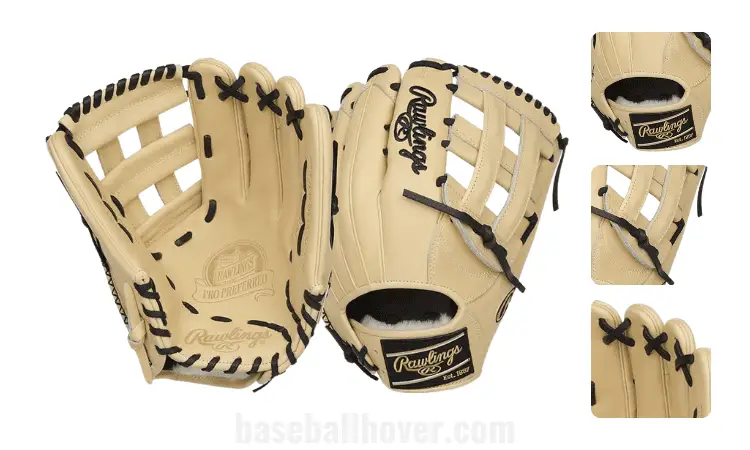

A short disclaimer before I get into the details – Rawlings Pro Preferred is one of the most expensive baseball gloves out there, and rightly so. It’s in the same league as the Wilson A2K, All-Star Pro-Elite, and Nokona X2 Elite. So, if you’re aware of any of the infield gloves mentioned here, you know how the price point in the big boy glove circle works.
If you’re looking for a great glove with a slightly less intimidating price, I’d suggest looking into the Rawlings Heart of the Hide. The Wilson A2000 and Mizuno Pro are also excellent choices. Take a look at these three alternatives if you don’t have the moolah to afford the Rawlings Pro Preferred.
Moving on – the Rawlings Pro Preferred is – in the simplest of terms – a professional infield glove. The quality of this is unparalleled. Ask any MLB pro or your coach. Most pro ballplayers would take the Rawlings Pro Preferred into without so much as a second thought. And that’s why it’s expensive.
For starters, the Pro Preferred doesn’t have the usual top 5% cowhide or premium US steer hide, aka Pro Stock from Wilson. This glove is made from ki – wait for it – wait for it because that’s the most sought-out leather material available in the whole world – kip leather. Yes, – kip leather.
Only a handful of gloves can sport the kip leather. If you’re not dishing out $400-$450 to get a Nokona Elite, you’ll be hard put to find a glove made of Kip leather.
Now, why am I getting all riled up about the leather material here? It’s just leather, right? Plain, simple, durable? The thing is – it’s not. Kip leather is different from all the other materials – cowhide, pigskin, buffalo skin, steer hide, etc.
Kip leather comes from calves. So, the leather is tight but with a soft texture, smooth but with a sturdy exterior. Built to last for years – most MLB pros get into the diamond with a kip leather glove. So, you can now see why I got excited.
Apart from the leather quality, it has an I-web. So, you have a complete vision of the incoming balls. The webbing, finger, and bridge design are different. It’s made in a way to help ballplayers scoop groundballs faster. Even the transfer is a cakewalk, thanks to the soft pocket and palm lining.
If you’ve used a baseball infielder’s glove before, you know how weak laces can be. I still have half a dozen gloves rotting on my shelf because the laces are broken beyond repair. But the Pro Preferred has solid lacing. I’ve used it for a long time without the laces falling apart. Although eventual use will lead to the laces’ death, you’ll get your money’s worth before it.
The one issue of the Pro Preferred that you – and many others like you – will struggle with is – the tough break-in ordeal. It has a 30% factory break-in – true. But it still takes quite some time. You need to take it out for a ride every other day to hit its peak.
The good thing, however, is that – once it’s broken in, the glove will retain shape. From there on out, you just put the glove on – no need for 5–10-minute adjustments.
Overall, the Rawlings Pro Preferred is more than deserving of the title – best infielders glove. The price can seem scary. But true quality demands a decent chunk of green, my friend. And the Pro Preferred is completely different from the average-joe infield gloves. And if you’re really into baseball, dreaming of becoming the next Derek Jeter or Cal Ripken Jr., give the Rawlings Pro Preferred a shot. You won’t regret it.
2. Mizuno Pro Select (best budget infielder gloves)
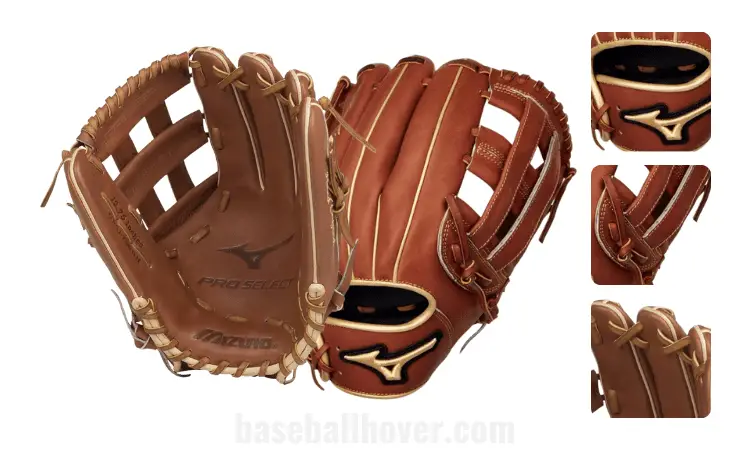

You should know that it’s okay if the Rawlings Pro Preferred is out of your budget range. Now, the ideal situation is where you get quality + a decent price point = Mizuno Pro Select. Mizuno Pro Select is an excellent mid-tier infield glove. The Easton Tournament Elite comes close, but Mizuno Pro Select has the edge.
The Pro Select doesn’t have Kip leather. But it has the second-best leather material – US steer hide. If you’ve been a long-term ballplayer, you already know that steer hides are no slouch when it comes to durability and performance. Yes – kip leather is a cut above the rest, but the gloves made from it are super expensive. In comparison, steer hides and cowhides are perfect for people with a smaller budget. Anyways, I’ve used this glove for nearly two seasons – and I play rough. The glove stood against all the beating – so no complaints.
Mizuno Pro Select has a range of different gloves – the infield category is divided into two sections. You’ve got the shallow pocket and a regular pocket version. So, you can choose the pocket style you prefer playing with. Usually, most infielders prefer shallow pockets because it’s easier to transfer and throw the ball. The shallow pocket version is not everyone’s cup of tea. Some people feel pretty uncomfortable with the change. And it does take some time to get used to the new feeling. So, if you’re not sure, just go with the regular pocket. But it’s good to have both options.
There are two webbing styles – I-web and Single-Post web. Both are almost similar in function, though. You get the visibility + groundball scooping is way easier. Plus, you’ve got a lot of different color options. The palm liner makes glove control a breeze. When I wore the glove for long hours, I didn’t feel any discomfort because of the palm liner’s design.
With all that said, the Mizuno Pro Select is a bargain if you ask me. It’s an incredible mid-tier glove. You get close-to-pro-level performance and durability at a reasonable price. It’s one of the best infield gloves that I’ve used. And it’s under $250—a bang for the buck.
3. Wilson A2000 Baseball Infield Glove (High-end Alternative Infield Glove)
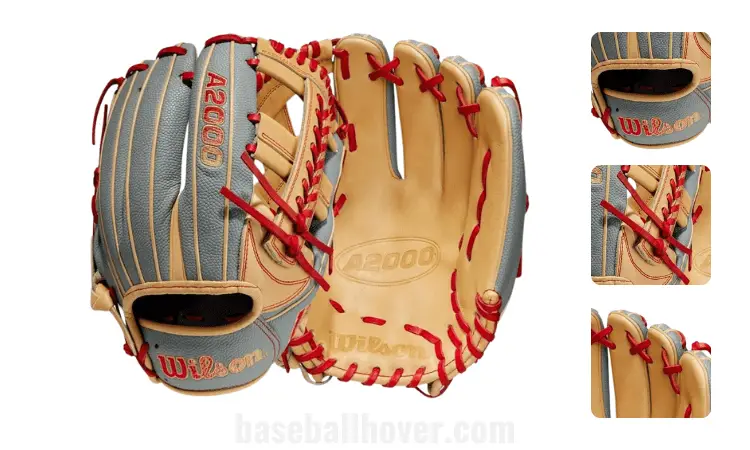

If you’ve been in the baseball community long enough, you should know – when it comes to gloves, the community (even MLB pros) is divided into three major brands. The three top dogs of baseball gloves are – Rawlings, Wilson, and All-Star. Now, nearly 50% of ballplayers get a Rawlings. But if you want to board the Wilson wagon, there’s no better glove than the A2000.
Now, there can be an argument that the Wilson A2K is better – and the truth is – yes, the A2K is better. However, the A2K also rips an extra $100 off your wallet. So, whether you want to save that and go with a *close-enough* glove, is up to you. My suggestion is – if you’re not going into MLB, you can have a killer season with the A2000.
Alright, so what’s the A2000’s arsenal? Amongst all the Wilson infield gloves, only A2000 and A2K have Pro Stock Leather. The Pro Stock Leather comes from the premium US steer hides. It makes the glove sturdy. I’ve seen A2000 infield gloves last for two seasons with ease. So, you don’t have to worry about durability. Plus, the Dustin Pedroia model that I have listed here has a classic I-web. (Remember, there are other models and size options available. The Dustin Pedroia is just one of many game-day models of the A2000.)
And more than 60% of infielders prefer I-web, so you’re covered. The bridge and fingers of the glove are designed specifically to scoop grounders. The laces on the bridge make scooping easier. It’s not just the bridge and the laces. The pocket design comes into the picture as well. It can help you transfer the balls quickly to your throwing hand. Despite the shallow depth, the palm padding is solid enough to handle fastballs hurling in at 80-100MPH.
And you’ve got all the different infield sizes – 11.25/11.5/11.75. So, whether you want to go fast and smooth with the 11.25 or get the 11.75 for more range and accuracy is up to you.
The only beef you’ll have with the A2000 – when you get it – is the tough break-in process. It’s not a 24–48-hour deal. If you want to break it in naturally, you’d have to take it out for a swing every day. However, if you follow some break-in techniques, you’ll get there faster. But it’ll have an adverse effect on the longevity of the glove.
Finally, the A2000 isn’t in the same league as the Pro Preferred. However, it’s on the same level as the Rawlings Heart of the Hide. And if you follow MLB, you know that a lot of infielders don the Rawlings HOH and the A2000. So, it’s a quality infield glove through and through.
People who are long-time fans of Wilson would swear by this glove and tell you that it’s the best infielder glove available. And they’re right. The Wilson A2000 is an incredible glove. But it’s one of the best gloves out there – not *the* best glove. So, if you don’t want to fall in the Rawlings line like everybody else and want to be different, you should definitely try the A2000.
4. Rawlings Player Preferred (Budget Infield Glove for Adults)
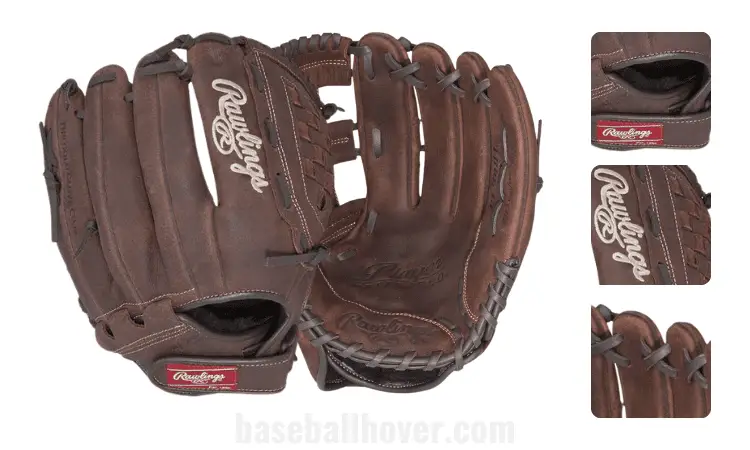

It’s not always about top-shelf performance, premium leather material, and all that shiny stuff. Sometimes, all we want is a simple, usable, and budget-friendly glove. It can be a great Thanksgiving/Christmas gift or a casual glove just to have fun on the weekends. So, for my casual cohort, I suggest you look into the Rawlings Player Preferred.
I’ve recommended the Rawlings Player Preferred so many times that I lost count. I’m a big fan of this glove, and there’s no reason to hide it. It’s the highest value budget glove in existence – period. And I’m not stretching it. Even if you look at some of the outfield baseball gloves, you’ll find the Rawlings Player Preferred listed there as well.
So, what makes the Player Preferred so good that it made my list multiple times? Answer – price to performance ratio. You pay peanuts for this glove – it’s sub-$80. But the quality is that of a $120-$150 glove. Don’t get me wrong, though. It can’t hold a candle to the big dogs like Rawlings Pro Preferred, Wilson A2000, Mizuno Pro, etc. However, as a budget infield glove, it doesn’t get any better than the Player Preferred.
Now, the leather used in this glove is synthetic. So, it’s not steer hide, cowhide, kip leather – not the *really good* stuff. But you can work with synthetic leather. I’ve had my Player Preferred for nearly two seasons before a portion of the web came apart. It’s durable enough to get you through casual games.
And there’s the palm padding. Even when you’re playing for fun, the incoming fastballs won’t show you any mercy in the field. So, every time you catch a fastball, it’s going to sting unless the palm padding is good. Yes – the sting can be minimized if you know how to pocket the ball with precision. But even pros have a hard time doing that. So, the Rawlings Player Preferred will keep your palms protected.
You’ve got the flex Velcro strap – so adjustment is pretty simple.
Let me dig up some dirt now. The Player Preferred infield glove comes in sizes 12 and above. So, the ideal 11.75 or 11.5 size isn’t available. That’s a problem. Ideally, you’d want 11.75 – some people prefer 11.5 as well. But no infielder – except the first baseman – go for 12-inch gloves.
And one more thing – it’s a super cheap glove. So, you need to keep your expectations grounded. Just because my Player Preferred endured for nearly two seasons doesn’t mean you’ll have the same experience. It would depend on how you’re using and maintaining the glove.
Still, the Rawlings Player Preferred is the best infield glove for the price. You can go even cheaper by getting a Franklin glove. But the performance would be far from ideal. Trust me – you’ll be hard put to find an adult infield glove of this caliber at such an affordable price point.
So, if you’re tight on budget, want to have some fun, or get a reasonable gift for your friends and family, go for the Rawlings Player Preferred.
5. Easton Tournament Elite Youth Infield Glove
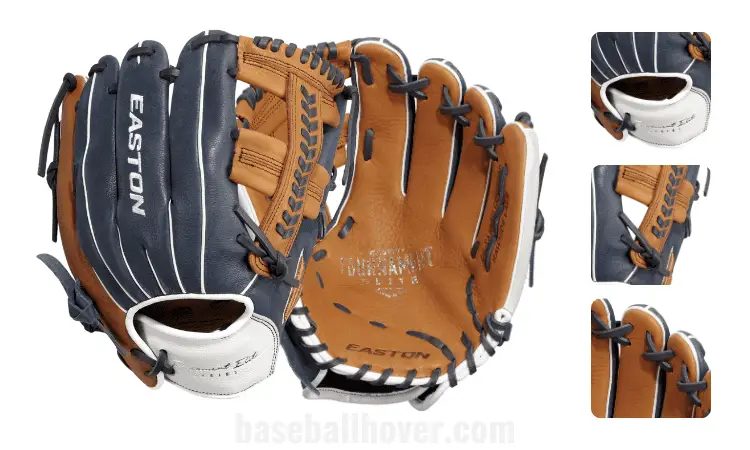

Youth travel ball is all the rage now. And the way kids are performing it’s going to become even bigger for years to come. All the gloves I’ve listed can be used by either high schoolers or adults. So, if you’re in the upper Junior League or Senior League, you can try those out.
However, travel ballplayers around 9-14 years may not fit into a Rawlings Pro Preferred or A2000. You have to try other youth infield gloves. (Look, I know what you’re thinking – they might fit. But sometimes they don’t. And from what I’ve seen, even if they do, it’s uncomfortable). That’s where the Easton Tournament Elite Youth comes into the mix.
It’s a pro-tier glove that’s not super expensive. That’s what makes the Easton Tournament Elite stand out from the crowd. For starters, the tanned cowhide leather of this glove makes it really comfortable. The tanning softens the leather – so it’s easy to control, open, and close.
The palm lining is also all leather. So, even if you miss the pocket while catching, the sting won’t be too tough for you to handle. And it has I-web – no visibility issues whatsoever. Plus, the finger, bridge, and webbing design help you scoop groundballs with ease.
And if you take a look into this glove, you’ll see that it says – “transitional size.” If you don’t know what that means, it can accommodate players of ages 9-14. Although it says 11.5-inch size, the wrist area can expand if you adjust the laces. So, I’ve seen 9U, and even 11U ballplayers use the glove.
The one thing I really like about this glove is the extra room in the pinky area. You can put two fingers in the pinkie area of the glove if you want some more control of the glove. Not everyone likes to adapt this two-finger-in-one-stall playstyle, but it’s always nice to have an extra option.
Finally, if you take a look at the I-web, you’ll see a snake-like pattern. The leather material is the same tanned cowhide though. But the I-web has a snaky texture, making it look like a high-end MLB infield glove. So, the Easton Tournament Elite isn’t just about performance. It gives you style points as well.
Long story short – the Easton Tournament Elite is an excellent glove. It’s just around $100, but the quality, feel control, and durability are almost similar to a high-end infield glove. In fact, when it comes to youth infield gloves, this one can give the big baddies a run for their money. That’s why – I think the Easton Tournament Elite is one of the best youth infield baseball gloves.
6. Jalunth Kids Youth Junior Infield Glove (Cheap Youth Infield Glove)
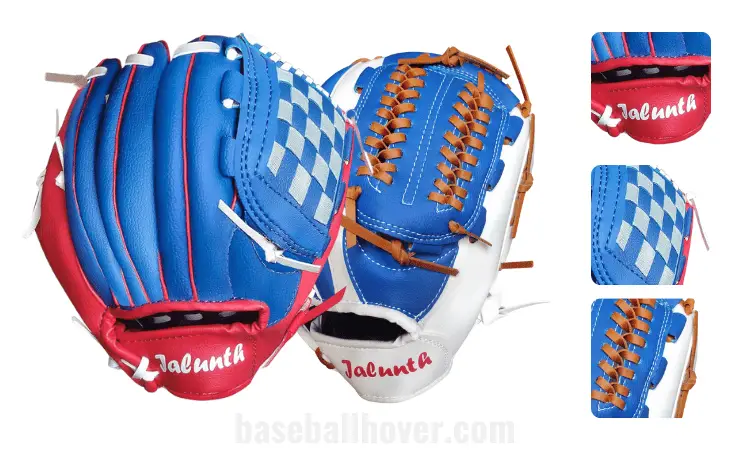

The glove that I’m about to highlight now may get people thinking that I’m off my rocker. Now, I wanted to go off-brand and see where it gets me. There’s not much out there. And the ones you find are bad with a capital B. Anyways, the Jalunth Kids Infield Glove stood out to me. Let me tell you why.
The first and most noticeable feature is – you guessed it – price. This is the cheapest infield glove on my list of best baseball infield gloves. The second-lowest would be the Player Preferred. The price hovers around $25-$30. So, it’s super cheap.
But it’s not a trash glove by any means. If you’ve got kids who are learning the ropes of defensive baseball plays, this is the perfect glove to get. It’ll help them understand the basics and make the entire experience fun. And you don’t end up spending north of $100 – a big plus.
The leather is synthetic. It’s nothing to write home about. But that’s not the point of this infield baseball glove anyways. Your little champ won’t be facing 60-80MPH fastballs – so it’s all good. What’s more important – the leather quality feels good around your palms and fingers when you put it on.
Although the manufacturer notes say the glove’s 90% broken in, the user needs to handle 10%. From my experience, I think the glove literally requires zero break-in time/effort. It’s ready for action right out of the box. My kid started using it minutes after he got his hands on it. And no complaints.
The Jalunth Youth Infield Glove has a basket web design with trapeze-like lacing on top of the basket. So, it’s more like a trapeze-basket design. Most utility gloves have basket web – so your kids can take this to any position they want. However, it does mean that it’s not similar to other dedicated baseball infield gloves.
But that’s okay because it’s a youth glove, after all.
In short, the Jalunth Kids Youth Infield Glove is a cheap glove meant for casual, recreational players who are new to the beautiful game of baseball. It can be an excellent gift. Plus, it can be the boost your kids need to fall in love with the game. Either way, you’ll get a lot of love for it and a lot of use out of this glove unless you take this baseball infielder’s glove to a serious game.
But if you want something more serious but don’t want to break the $50 budget wall, go for the Wilson A360. And people who can dish out a bit more money should try out the Rawlings Sandlot Infield Glove.
A Detailed Guide on Choosing the best infield gloves
Whether you’re eyeing out for the best infield baseball gloves, the features you’d want are pretty much the same. There’ll definitely be a few different considerations because of the sizing and construction. However, the core features are similar. Anyways, I’m going to give you a short checklist of things you should keep in mind when hunting down good infield gloves.
Material And Construction (What Should You Get and Why?)
When it comes to the material of the baseball glove, there are plenty of options. Naturally, some of them are high quality, and some of them are poor. Five types of leather are mostly used to make a baseball glove.
· Buffalo skin
Durable but stiff. It’ll be the hardest to break in. However, once you can overcome that hurdle, it’ll last for a long time.
· Kip leather
One of the most premium leathers in existence. Yes – it’s stiff, but the break-in is relatively comfortable. The overall smoothness, feel, and quality of a kip leather glove is incredible. The Rawlings Pro Preferred infield glove is made with Kip leather.
· Cowhide
The standard leather of most baseball gloves. Cowhide infield gloves are a benchmark in the community. You can use these leather gloves for an entire season or more if you maintain them. Besides, the performance is really good.
· Premium Steerhide
Used mostly by Wilson A2000 and A2K infield glove series, the US steer hide is another highly sought-after leather. It’s extremely durable and sometimes can last for multiple seasons. However, the gloves are tough as hell – takes time to break-in. Even after breaking it in, the glove can remain stiff. Still, it’s one of the better leathers out there. These five leather materials are the best in the business. When it comes to baseball fielding gloves, there’s no beating these fabulous five. Apart from the ones mentioned here, you’ll also find synthetic leather and pigskin. Both are used in budget-friendly infield gloves.
So, when you’re selecting a proper baseball infielder’s glove, you need to figure out what leather you want. That’s priority numero uno. So, think carefully – and remember your budget plays a big role in the leather quality you get.
Pocket (Shallow or Standard)
Pocket is an essential part of any baseball glove. While there are two types of pockets (standard and shallow), most infielders go with a shallow pocket. Now, this isn’t universal. Not everyone can handle the shallow-pocket playstyle.
Anyways, if you want to get quick transfers, a shallow pocket is your bet. But the standard pocket gives you more control. The problem with a shallow pocket is that there’s a big chance of the ball missing the pocket entirely and rebounding off the glove. In that case, a base steal is a must.
So, you need to be sure of the playstyle you want. While shallow is an action-packed, high-risk-high-reward playstyle, the standard pocket is a much safer option.
Left Hand or Right Hand (Don’t Mess the Hand Orientation)
Most of the infielder glove comes with a two-hand orientation. LHT means to throw the ball with your left hand and gloves on the right. And RHT means to throw the ball with your right hand and gloves on the left. Before buying, make sure you’ve selected the exact one. However, some manufacturers have it the other way round, whereas RHT gloves are for your right hand. So, read the descriptions carefully.
Padding (To Save You from Fastball Impact)
The padding of a baseball glove helps you to catch the ball more comfortably without injuring your palm. When you’re unable to pocket a ball, and it hits an awkward spot in the glove, you usually feel a sting.
However, you can minimize the sting by getting a baseball infielder’s glove with thick and strong padding. Even if you miss the pocket with an incoming fastball, the palm padding should take care of the impact. It won’t take the sting of the impact and the pain out of the picture, but the padding will reduce it.
Adjustable Wrist (More Flexibility to You)
Every ballplayer will have a different hand size. Even when there’s a standard, there will be slight differences in the wrist. That’s why everyone needs a different-size glove to catch comfortably. So, it’s best if you get an infield glove with an adjustable wrist. You can change the closure as you want.
Remember, youth gloves have smaller wrist openings or heels.
Affordable Price (Expectations vs. Reality)
Everyone wishes to get an ideal baseball glove at an affordable price. But everything good in life has a big price tag – apart from abstract concepts like love and loyalty. Coming back to the point – an ideal infield glove can set you back by $250-$300. If you want something truly unique and high-ticket, you have to go as high as $500. The Rawlings Pro Preferred I’ve listed in the “high-ticket” category.
However, you can get a lot out of a $200-$250 glove. The Rawlings Heart of the Hide or Wilson A2000 are completely reasonable infield gloves.
Size (Perfect Size = Perfect Game)
The sizing of infield gloves is pretty simple. Infield gloves have three different sizes –
- 11.25 – A bit smaller. But some people who want super-fast transfers go for the 11.25-inch infield glove. Only a handful of people
- 11.5 – Perfect size for middle infielders. You have everything you can ask for with this size – reach, shallow pocket for fast transfers, and more control. So, the ideal size for infielders.
- 11.75 – Better suited for third basemen. It gives you more reach, but it’s a bit harder to control and transfer balls. However, it’s still a pretty solid size for infielders who are likely to change positions during the game.
Break-In Period (Long vs. Short)
There are so many gloves that come with a factory break-in. But you still need to take it out and use it to get it ready for the game. Plus, only synthetic leather gloves or pigskin gloves have a short break-in period. Remember, true leather gloves will always be stiff. And it’ll take some time and effort to get it to a full 100%. So, you have to be patient. Don’t get annoyed when a glove takes time to break-in. If it’s taking time, it probably means the glove is really durable and sturdy.
You can always work around this by trying to break the glove in manually. But you should also know that any manual interference can (and probably will) reduce the glove’s lifespan.
FAQ
Here’s a list of the most common questions I get as a coach. I’ve tried to provide a clear and succinct answer to help you out.
What glove do most MLB infielders use?
Most MLB infielders use Rawlings gloves. A close second would be Wilson. So, the Pro Preferred or the Heart of the Hide from Rawling’s arsenal and the A2000 or A2K from Wilson’s repertoire is what MLB pros use.
But you should know that most MLB infielders have their gloves custom-made. Even if you get the brand right, there’ll be differences. If you want to know more read this blog: WHAT GLOVES DO MLB PLAYERS WEAR?
What gloves do middle infielders use?
Middle infielders – also known as shortstops – use 11.5-inch I-web infield gloves. Now, there’s no exact answer to what brand a particular middle infielder prefers. But once you get the size and webbing right, you can either go with Rawlings or Wilson.
What makes a good infield glove?
I’ve already discussed it above. But the three things that really matter when it comes to choosing a quality infield glove is –
- Leather quality
- Palm padding
- Breathability of the glove fabric
What is the best size glove for an infielder?
The ideal size is 11.5-inches. It gives enough reach + easy ball transfers. That’s all you need as an infielder. But third basemen sometimes need more reach. So, they can go for an 11.75-inch glove. And people who want even quicker transfers can try the 11.25-inch gloves out.
Control the Infield
As I said earlier, as an infielder, you’ll always be in the midst of the action. Home runs are hard to come by. But bunts, random hits, base steal attempts will happen – All. The. Time! So, you have to be on your toes to stop as many runs as possible to create pressure on the pitchers of the opposing team. And you can’t do that with an infield glove that sucks. You need the best infield baseball glove to bring your A-game out.
I know – some infield gloves can be expensive. But think of it as a long-term investment. And if you want a mid-tier glove like the Mizuno Pro. Still, I would recommend going for one of the three – Rawlings Pro Preferred (if you have the money), Heart of the Hide (a little less expensive), or Wilson A2000 (alternative to the HOH).
So, don’t let the hitters get the best of you. Stop any runs possible – create pressure – win. Simple. That’s all I have when it comes to the best baseball infield gloves. Now, go out there, and make some plays. Cheers!
